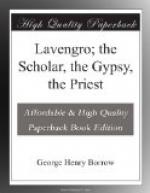Whereupon my brother gave him a brief account of his commission. At the mention of the hundred pounds, I observed the eyes of the painter glisten. ‘Really,’ said he, when my brother had concluded, ’it was very kind to think of me. I am not very fond of painting portraits; but a mayor is a mayor, and there is something grand in that idea of the Norman arch. I’ll go; moreover, I am just at this moment confoundedly in need of money, and when you knocked at the door, I don’t mind telling you, I thought it was some dun. I don’t know how it is, but in the capital they have no taste for the heroic, they will scarce look at a heroic picture; I am glad to hear that they have better taste in the provinces. I’ll go; when shall we set off?’
Thereupon it was arranged between the painter and my brother that they should depart the next day but one; they then began to talk of art. ’I’ll stick to the heroic,’ said the painter; ’I now and then dabble in the comic, but what I do gives me no pleasure, the comic is so low; there is nothing like the heroic. I am engaged here on a heroic picture,’ said he, pointing to the canvas; ’the subject is “Pharaoh dismissing Moses from Egypt,” after the last plague—the death of the first-born; it is not far advanced—that finished figure is Moses’: they both looked at the canvas, and I, standing behind, took a modest peep. The picture, as the painter said, was not far advanced, the Pharaoh was merely in outline; my eye was, of course, attracted by the finished figure, or rather what the painter had called the finished figure; but, as I gazed upon it, it appeared to me that there was something defective—something unsatisfactory in the figure. I concluded, however, that the painter, notwithstanding what he had said, had omitted to give it the finishing touch. ‘I intend this to be my best picture,’ said the painter; ’what I want now is a face for Pharaoh; I have long been meditating on a face for Pharaoh.’ Here, chancing to cast his eye upon my countenance, of whom he had scarcely taken any manner of notice, he remained with his mouth open for some time. ‘Who is this?’ said he at last. ’Oh, this is my brother, I forgot to introduce him.’ . . .
We presently afterwards departed; my brother talked much about the painter. ‘He is a noble fellow,’ said my brother; ’but, like many other noble fellows, has a great many enemies; he is hated by his brethren of the brush—all the land and water scape painters hate him—but, above all, the race of portrait-painters, who are ten times more numerous than the other two sorts, detest him for his heroic tendencies. It will be a kind of triumph to the last, I fear, when they hear he has condescended to paint a portrait; however, that Norman arch will enable him to escape from their malice—that is a capital idea of the watchmaker, that Norman arch.’




